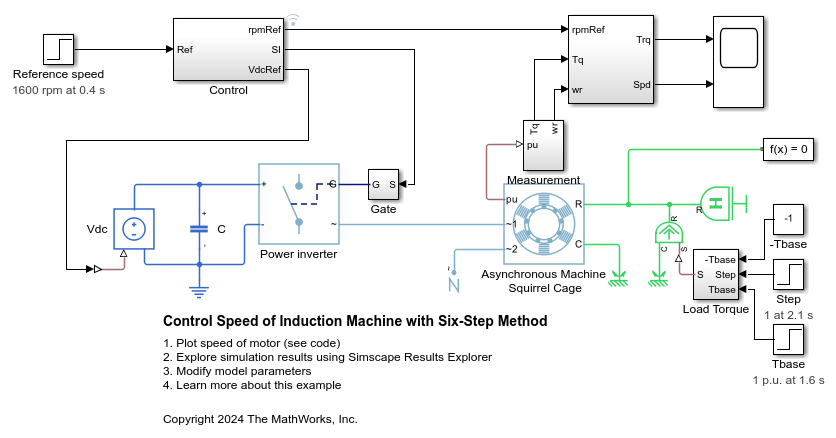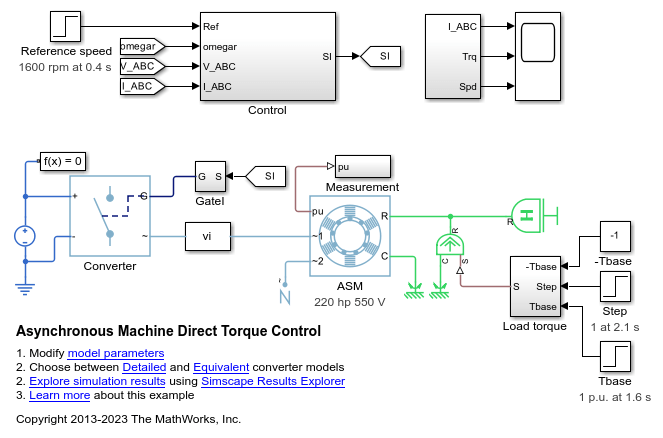Induction Machine Squirrel Cage
Squirrel-cage-rotor induction machine with per-unit or SI parameterization
Libraries:
Simscape /
Electrical /
Electromechanical /
Asynchronous
Description
The Induction Machine Squirrel Cage block models a squirrel-cage-rotor induction machine with fundamental parameters expressed in per-unit or in the International System of Units (SI). A squirrel-cage-rotor induction machine is a type of induction machine. All stator connections are accessible on the block. Therefore, you can model soft-start regimes using a switch between wye and delta configurations. If you need access to the rotor windings, use the Induction Machine Wound Rotor block instead.
Connect port ~1 to a three-phase circuit. To connect the stator in delta configuration, connect a Phase Permute block between ports ~1 and ~2. To connect the stator in wye configuration, connect port ~2 to a Grounded Neutral (Three-Phase) or a Floating Neutral (Three-Phase) block.
Induction Machine Initialization Using Load-Flow Target Values
If the block is in a network that is compatible with the frequency-time simulation mode, you can perform a load-flow analysis on the network. A load-flow analysis provides steady-state values that you can use to initialize the machine.
For more information, see Perform a Load-Flow Analysis Using Simscape Electrical and Frequency and Time Simulation Mode. For an example that shows how initialize an induction machine using data from a load flow analysis, see Induction Motor Initialization with Loadflow.
Equations
For the SI implementation, the block converts the SI values that you enter to per-unit values for simulation. The converted values are based on the machine being connected in a delta-winding configuration.
For the per-unit implementation, you must specify the resistances and inductances in the impedances tab based on the machine being connected in a delta-winding configuration.
For information on the relationship between SI and per-unit machine parameters, see Per-Unit Conversion for Machine Parameters. For information on per-unit parameterization, see Per-Unit System of Units.
The induction machine equations are expressed with respect to a synchronous reference frame, defined by
where frated is the value of the Rated electrical frequency parameter.
The Park transformation maps stator equations to a reference frame that is stationary with respect to the rated electrical frequency. The Park transformation is defined by
where θe is the electrical angle.
The Park transformation is used to define the per-unit induction machine equations. The stator voltage equations are defined by
and
where:
vds, vqs, and v0s are the d-axis, q-axis, and zero-sequence stator voltages, defined by
va, vb, and vc are the stator voltages across ports ~1 and ~2.
ωbase is the per-unit base electrical speed.
ψds, ψqs, and ψ0s are the d-axis, q-axis, and zero-sequence stator flux linkages.
Rs is the stator resistance.
ids, iqs, and i0s are the d-axis, q-axis, and zero-sequence stator currents defined by
ia, ib, and ic are the stator currents flowing from port ~1 to port ~2.
The rotor voltage equations are defined by
and
where:
vdr and vqr are the d-axis and q-axis rotor voltages.
ψdr and ψqr are the d-axis and q-axis rotor flux linkages.
ω is the per-unit synchronous speed. For a synchronous reference frame, the value is 1.
ωr is the per-unit mechanical rotational speed.
Rrd is the rotor resistance referred to the stator.
idr and iqr are the d-axis and q-axis rotor currents.
The stator flux linkage equations are defined by
and
where Lss is the stator self-inductance and Lm is the magnetizing inductance.
The rotor flux linkage equations are defined by
and
where Lrrd is the rotor self-inductance referred to the stator.
The rotor torque is defined by
The stator self-inductance Lss, stator leakage inductance Lls, and magnetizing inductance Lm are related by
The rotor self-inductance Lrrd, rotor leakage inductance Llrd, and magnetizing inductance Lm are related by
When a saturation curve is provided, the equations to determine the saturated magnetizing inductance as a function of magnetizing flux are:
For no saturation, the equation reduces to
Plotting and Display Options
You can perform plotting and display actions using the Electrical menu on the block context menu.
Right-click the block and, from the Electrical menu, select an option:
Display Base Values — Displays the machine per-unit base values in the MATLAB® Command Window.
Plot Torque Speed (SI) — Plots torque versus speed, both measured in SI units, in a MATLAB figure window using the current machine parameters.
Plot Torque Speed (pu) — Plots torque versus speed, both measured in per-unit, in a MATLAB figure window using the current machine parameters.
Plot Open-Circuit Saturation — Plots terminal voltage versus no-load line current, both in per-unit, in a MATLAB figure window. The plot contains three traces:
Unsaturated — Stator magnetizing inductance (unsaturated).
Saturated — Open-circuit lookup table (v versus i) you specify.
Derived — Open-circuit lookup table derived from the per-unit open-circuit lookup table (v versus i) you specify. This data is used to calculate the saturated magnetizing inductance, Lm_sat, and the saturation factor, Ks, versus magnetic flux linkage, ψm, characteristics.
Plot Saturation Factor — Plots saturation factor, Ks, versus magnetic flux linkage, ψm, in a MATLAB figure window using the machine parameters. This parameter is derived from other parameters that you specify:
No-load line current saturation data, i
Terminal voltage saturation data, v
Leakage inductance, Lls
Plot Saturated Inductance — Plots magnetizing inductance, Lm_sat, versus magnetic flux linkage, ψm, in a MATLAB figure window using the machine parameters. This parameter is derived from other parameters that you specify:
No-load line current saturation data, i
Terminal voltage saturation data, v
Leakage inductance, Lls
For the SI implementation, v is in V (phase-phase RMS) and i is in A (rms).
Model Thermal Effects
You can expose thermal ports to simulate the effects of generated heat and motor temperature. To expose the thermal ports and the Thermal parameters, set the Modeling option parameter to either:
No thermal port— The block contains electrical conserving ports associated with the stator windings, but does not contain thermal ports.Show thermal port— The block contains expanded electrical conserving ports associated with the stator windings and thermal conserving ports for each of the windings and for the rotor.
For more information about using thermal ports in actuator blocks, see Simulating Thermal Effects in Rotational and Translational Actuators.
Variables
To set the priority and initial target values for the block variables prior to simulation, use the Initial Targets section in the block dialog box or Property Inspector. For more information, see Set Priority and Initial Target for Block Variables.
Nominal values provide a way to specify the expected magnitude of a variable in a model. Using system scaling based on nominal values increases the simulation robustness. Nominal values can come from different sources, one of which is the Nominal Values section in the block dialog box or Property Inspector. For more information, see System Scaling by Nominal Values.
The type of variables that are visible in the Initial Targets section depends on the initialization method that you select, in the Main section, for the Initialization option parameter. To specify target values using:
Flux variables — Set the Initialization option parameter to
Set targets for flux variables.Data from a load-flow analysis — Set the Initialization option parameter to
Set targets for load flow variables.
If you select
Set targets for load flow variables, to fully specify the initial
condition, you must include an initialization constraint in the form of a high-priority target
value. For example, if your induction machine is connected to an Inertia block, the initial condition for the induction machine is
completely specified if, in the Initial Targets section of the
Inertia block, the
Priority for Rotational velocity is set to
High. Alternatively, you could set the
Priority to None for the Inertia block Rotational velocity, and instead set the
Priority for the induction machine block Slip,
Real power generated, or Mechanical power consumed
to High.
Examples
Ports
Input
Conserving
Parameters
References
[1] Kundur, P. Power System Stability and Control. New York: McGraw Hill, 1993.
[2] Lyshevski, S. E. Electromechanical Systems, Electric Machines and Applied Mechatronics. Boca Raton, FL: CRC Press, 1999.
[3] Ojo, J. O., Consoli, A.,and Lipo, T. A., "An improved model of saturated induction machines", IEEE Transactions on Industry Applications. Vol. 26, no. 2, pp. 212-221, 1990.
Extended Capabilities
Version History
Introduced in R2013bSee Also
Simscape Blocks
Blocks
- Induction Machine Current Controller | Induction Machine Direct Torque Control | Induction Machine Direct Torque Control with Space Vector Modulator | Induction Machine Field-Oriented Control | Induction Machine Flux Observer | Induction Machine Scalar Control | Induction Machine Direct Torque Control (Single-Phase) | Induction Machine Field-Oriented Control (Single-Phase)












